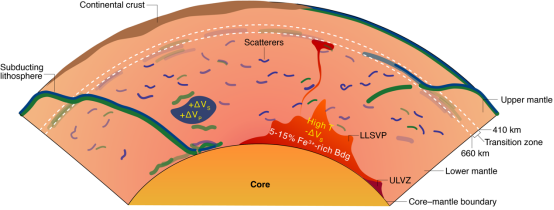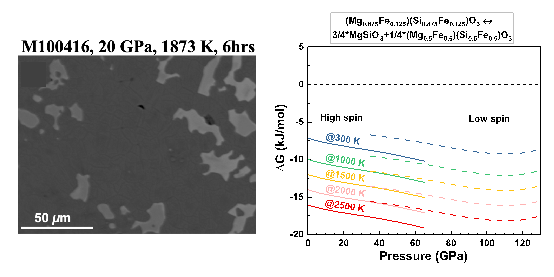Dr. WANG Wenzhong, and Prof. WU Zhongqing from University of Science and Technology of China (USTC) of the Chinese Academy of Sciences (CAS), collaborating with researchers from Michigan State University and Arizona State University, discovered that Large Low Shear Velocity Provinces (LLSVPs) may have originated from the magma sea in the early evolution of the Earth. This work was published in Nature Communications.
The lower mantle is one of the most important layers of the Earth's interior and it is the ballast of the Earth’s evolution. Scientists have discovered the existence of many anomalies of different scales in the lower mantle, including large scale high- and low- velocity anomalies and small scale scatterers. LLSVPs is the largest low-velocity anomaly in the lower mantle beneath Africa and the Pacific, extending laterally and vertically up to thousands of kilometers.

Anomalies of lower mantle materials and their sources (Image by WANG Wenzhong)
The origin of anomalies of different scales plays a key role in understanding the internal structure and material composition of the Earth. Previous study of this group has found that presence of subducted oceanic crust can well explain the origin of small scale scatterers and large scale high-velocity anomalies, but the formation of LLSVPs still remains unknown.
The main mineral in the lower mantle is Bridgmanite (Bdg), which is the main carrier of iron in the lower mantle. Ferrous iron (Fe2+) in magma was found to disproportionate into ferric iron (Fe3+) and metallic iron (Fe0). The separation of Fe0 from magma into the core leads to the enrichment of Fe3+ in the lower mantle.
In this study, researchers conducted high pressure-temperature experiments and ab initio calculations, and found that moderate Fe3+-rich Bdg will decompose into extremely Fe3+-rich Bdg and Fe3+-poor Bdg. The newly discovered Fe3+-rich Bridgmanite possesses low wave velocity, high Poisson's ratio and high density.
Further calculations indicated that, 5-15% Fe3+ rich Bridgmanite enriched in normal mantle can well explain the seismological observations of LLSVPs. Geodynamic simulation showed that this heterogeneous anomaly can form a structure which is similar to LLSVPs in the lower mantle.

The formation of extremely Fe3+-rich Bdg (Image by WANG Wenzhong)
The discovery of Fe3+ rich Bridgmanite in LLSVPs will have an important influence on our understanding of the deep structure of the Earth, the interaction of the stratosphere and the migration and action of volatiles in the Earth.
Paper link:
https://doi.org/10.1038/s41467-021-22185-1
(Written by LU Hongyu, edited by JIANG Pengcen, USTC News Center)